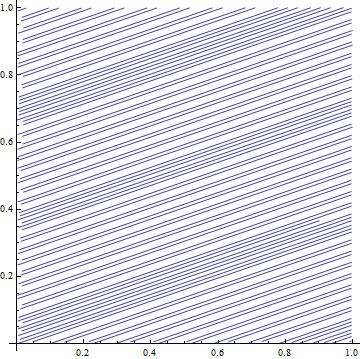 | ||
In mathematics, especially in the area of mathematical analysis known as dynamical systems theory, a linear flow on the torus is a flow on the n-dimensional torus
Contents
which is represented by the following differential equations with respect to the standard angular coordinates (θ1, θ2, ..., θn):
The solution of these equations can explicitly be expressed as
If we represent the torus as
For a linear flow on the torus either all orbits are periodic or all orbits are dense on a subset of the n-torus which is a k-torus. When the components of ω are rationally independent all the orbits are dense on the whole space. This can be easily seen in the two dimensional case: if the two components of ω are rationally independent then the Poincaré section of the flow on an edge of the unit square is an irrational rotation on a circle and therefore its orbits are dense on the circle, as a consequence the orbits of the flow must be dense on the torus.
Irrational winding of a torus
In topology, an irrational winding of a torus is a continuous injection of a line into a two-dimensional torus that is used to set up several counterexamples. A related notion is the Kronecker foliation of a torus, a foliation formed by the set of all translates of a given irrational winding.
Definition
One way of constructing a torus is as the quotient space
Applications
Irrational windings of a torus may be used to set up counter-examples related to monomorphisms. An irrational winding is an immersed submanifold but not a regular submanifold of the torus, which shows that the image of a manifold under a continuous injection to another manifold is not necessarily a (regular) submanifold. Irrational windings are also examples of the fact that the induced submanifold topology does not have to coincide with the subspace topology of the submanifold.
Secondly, the torus can be considered as a Lie group
